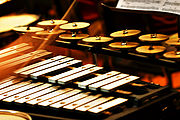
Crotales
Encyclopedia

Percussion instrument
A percussion instrument is any object which produces a sound when hit with an implement or when it is shaken, rubbed, scraped, or otherwise acted upon in a way that sets the object into vibration...
s consisting of small, tuned bronze or brass disks. Each is about 4 inches in diameter with a flat top surface and a nipple on the base. They are commonly played by being struck with hard mallets. However, they may also be played by striking two disks together in the same manner as finger cymbals, or by bowing. Their sound is rather like a small tuned bell
Bell (instrument)
A bell is a simple sound-making device. The bell is a percussion instrument and an idiophone. Its form is usually a hollow, cup-shaped object, which resonates upon being struck...
, only with a much brighter sound, and a much longer resonance.
Modern crotales are arranged chromatic
Chromatic scale
The chromatic scale is a musical scale with twelve pitches, each a semitone apart. On a modern piano or other equal-tempered instrument, all the half steps are the same size...
ally and have a range of up to two octave
Octave
In music, an octave is the interval between one musical pitch and another with half or double its frequency. The octave relationship is a natural phenomenon that has been referred to as the "basic miracle of music", the use of which is "common in most musical systems"...
s. They are typically available in sets (commonly one octave), but may also be purchased individually. Crotales are treated as transposing instrument
Transposing instrument
A transposing instrument is a musical instrument for which written notes are read at a pitch different from the corresponding concert pitch, which a non-transposing instrument, such as a piano, would play. Playing a written C on a transposing instrument will produce a note other than concert C...
s; music for crotales is written two octaves lower than the sounding pitch.
One of the earliest uses of crotales in the orchestral repertoire is Claude Debussy
Claude Debussy
Claude-Achille Debussy was a French composer. Along with Maurice Ravel, he was one of the most prominent figures working within the field of impressionist music, though he himself intensely disliked the term when applied to his compositions...
's Prélude à l'après-midi d'un faune
Prélude à l'après-midi d'un faune
Prélude à l'après-midi d'un faune , commonly known by its English title Prelude to the Afternoon of a Faun, is a symphonic poem for orchestra by Claude Debussy, approximately 10 minutes in duration...
. Another orchestral piece, From Me Flows What You Call Time by Toru Takemitsu
Toru Takemitsu
was a Japanese composer and writer on aesthetics and music theory. Largely self-taught, Takemitsu possessed consummate skill in the subtle manipulation of instrumental and orchestral timbre...
, features crotales (as well as a host of other bells) in a prominent role. In Joseph Schwantner
Joseph Schwantner
Joseph C. Schwantner is a Pulitzer Prize winning American composer and educator and a member of the American Academy of Arts and Letters. He was awarded the 1970 Charles Ives Prize....
's ...and the mountains rising nowhere the composer calls for the instrument to be bowed with a double bass bow, producing an eerie, sustained glass harmonica
Glass harmonica
The glass harmonica, also known as the glass armonica, bowl organ, hydrocrystalophone, or simply the armonica , is a type of musical instrument that uses a series of glass bowls or goblets graduated in size to produce musical tones by means of friction The glass harmonica, also known as the glass...
-like effect.
This effect is also used in Frank Ticheli's Vesuvius.
In Igor Stravinsky
Igor Stravinsky
Igor Fyodorovich Stravinsky ; 6 April 1971) was a Russian, later naturalized French, and then naturalized American composer, pianist, and conductor....
's The Rite of Spring
The Rite of Spring
The Rite of Spring, original French title Le sacre du printemps , is a ballet with music by Igor Stravinsky; choreography by Vaslav Nijinsky; and concept, set design and costumes by Nicholas Roerich...
, the score calls for two crotales in A-flat and B-flat. Stravinsky's Les Noces
Les Noces
Les noces by Igor Stravinsky, is a dance cantata, or ballet with vocalists.-History:The ballet was premiered on June 13, 1923 at the Théâtre de la Gaîté, by the Ballets Russes with choreography by Bronislava Nijinska...
ends on a plaintive series of chords struck by a combination of chimes and crotales.
Crotales are also found in prehistory. The National Museum of Ireland has several examples on display dating from the late Bronze Age (1200-800BC) which were found in a hoard alongside various brass wind instruments.
Rock drummer Neil Peart
Neil Peart
Neil Ellwood Peart , OC, is a Canadian musician and author. He is the drummer for the rock band Rush.Peart grew up in Port Dalhousie, Ontario . During adolescence, he floated from regional band to regional band in pursuit of a career as a full-time drummer...
uses crotales as part of his basic drumkit.
Jocie Adams of The Low Anthem
The Low Anthem
The Low Anthem is an American indie folk band from Providence, Rhode Island, formed in 2006. The band consists of multi-instrumentalists Ben Knox Miller, Jeff Prystowsky and Jocie Adams, and rose to prominence with the re-release of its third studio album, Oh My God, Charlie Darwin, in 2009.In...
plays the instrument in the bowed manner in their live shows.
Songwriter Rufus Wainwright uses the crotales to percussive effect in his song "Beauty Mark," from his self-titled debut album in 1998.

